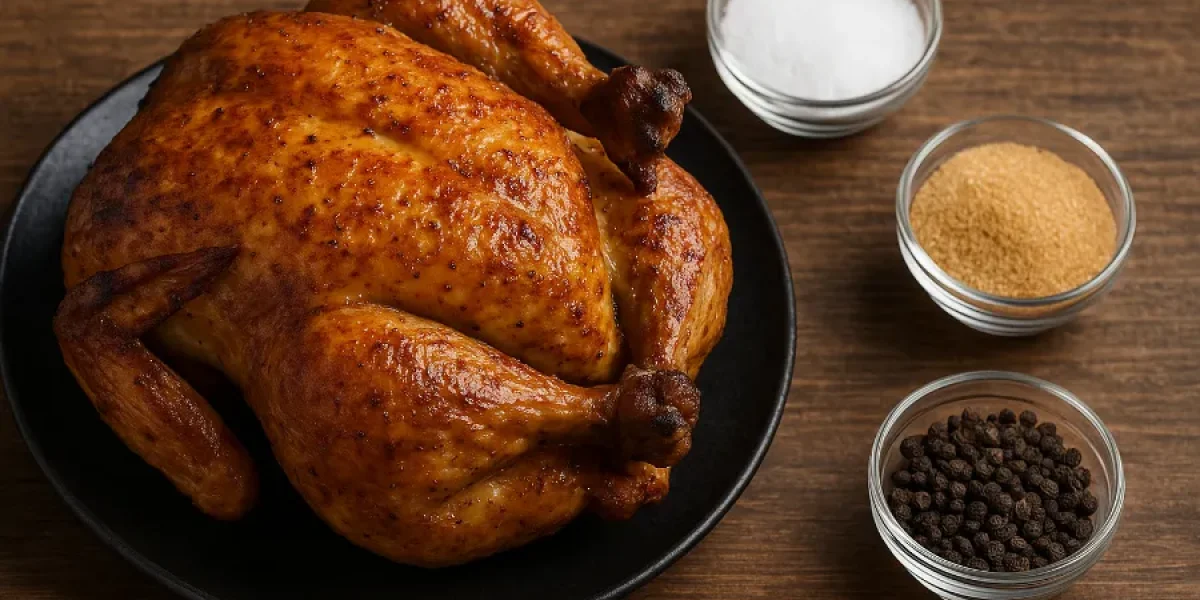I never thought a simple spoonful of sugar could completely change my chicken game — until I tried sugar in chicken brine for crispy skin.
One evening, I soaked a whole chicken overnight in a sugar brine instead of the usual saltwater mix, and the next day the skin came out so golden, glossy, and crackly that everyone at the table thought I had deep-fried it. That’s when I realized: the secret to crispy, juicy chicken isn’t just salt. It’s sugar.
If you love that combination of juicy meat and shatter-crispy skin, this post is for you. Let’s talk about the power of sugar brine, why it works, which sugars give the best results, and how to use it for roasting, grilling, or smoking chicken.
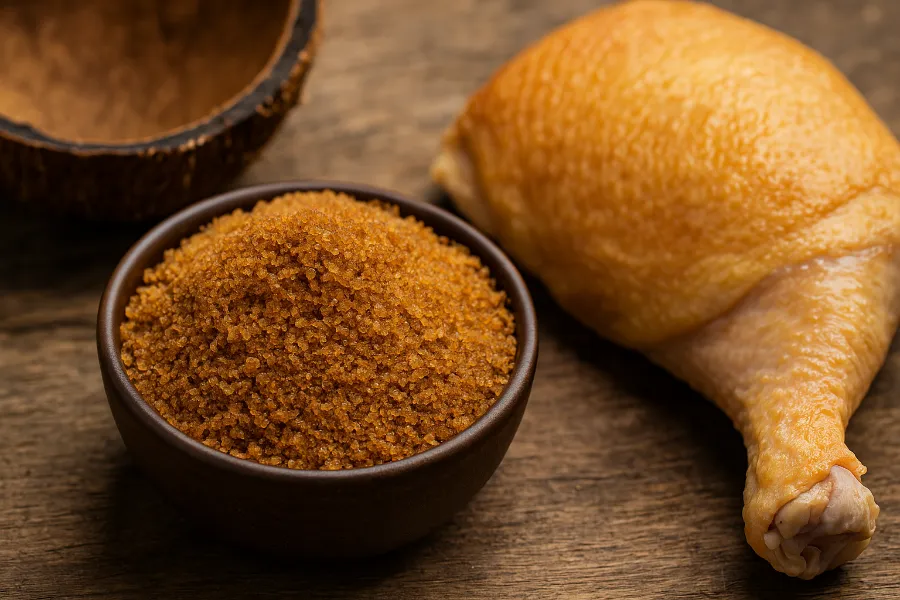
Chicken Brining: The Foundation of Juicy, Crispy Chicken
Brining is where every great chicken begins. Chicken brining simply means soaking poultry in a mix of water and salt so it absorbs extra moisture and flavor before cooking. The salt works its way into the meat, breaking down muscle proteins and allowing the chicken to retain more liquid.
The result? Moist, tender meat that doesn’t dry out in the oven or on the grill.
But there’s more to the story. The moment you add sugar to that brine, everything changes. Salt ensures tenderness, but sugar ensures texture and crispness. Together, they balance flavor, moisture, and browning — and that’s the trifecta for perfect chicken.
Crispy Chicken Skin: The Sweet Science Behind It
When you include sugar in your brine, it does much more than sweeten. It transforms the surface of the chicken in a few critical ways that lead to irresistibly crispy chicken skin.
1. Sugar Feeds the Maillard Reaction
The Maillard reaction is the golden-brown magic that happens when heat hits amino acids and sugars on the chicken’s surface. Sugar acts as the catalyst, intensifying color and depth. When your chicken hits the oven or grill, those tiny sugar molecules react with proteins in the skin, creating hundreds of flavor compounds — and that signature crisp, brown crust.
2. Sugar Enhances Caramelization
While the Maillard reaction creates roasted, savory notes, caramelization adds that slightly sweet, nutty tone and glossy finish. It’s the reason brined chicken turns golden rather than gray, with skin that’s beautifully blistered and aromatic.
3. Sugar Helps the Skin Dry Out (Which Means Crispy Skin Later)
Dry skin equals crispy skin. Sugar helps draw a bit of surface moisture out during the resting phase. When you air-dry brined chicken in the fridge, that tiny bit of sugar left behind attracts and then releases moisture evenly — so when the heat hits, the skin tightens and crisps instead of steaming.
4. Sugar Balances Salt and Flavor
Salt on its own can make chicken taste one-note or overly briny. Sugar softens that sharpness and rounds out the seasoning. The final flavor is savory, juicy, and delicately balanced — never salty, never bland.
Grilled Chicken Brine: Sweet, Smoky, and Perfectly Crisp
If you’ve ever grilled chicken and ended up with soggy skin or uneven color, try switching to a grilled chicken brine that includes sugar. The combination of fire, smoke, and sweetness works beautifully together.
Here’s my favorite formula:
- 1 gallon water
- 1 cup kosher salt
- ¾ cup sugar (half white, half brown)
- A handful of garlic cloves, peppercorns, and lemon peel
Let the chicken brine for a few hours (or overnight if it’s a whole bird). Then rinse, pat dry, and refrigerate uncovered for a few hours before grilling.
Grill first over indirect heat to cook the meat gently, then finish over direct heat to crisp the skin. The sugar in the brine caramelizes on the surface, creating that smoky, bronzed color and paper-thin crunch.
Types of Sugar for Crispy Chicken Skin
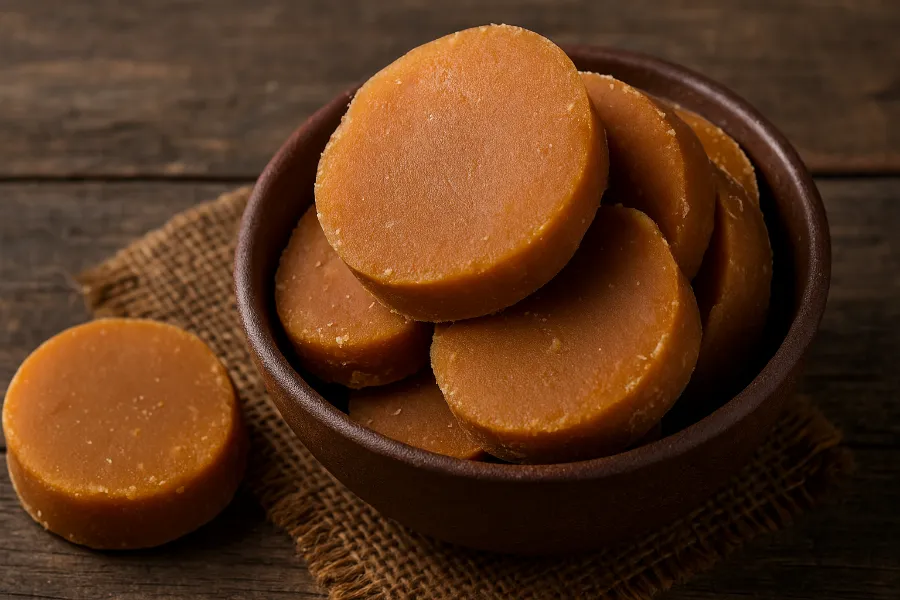
Now for the fun part — choosing your sugar. Different sugars caramelize at different temperatures and create distinct textures. Here’s what I’ve learned after dozens of brining experiments.
White Granulated Sugar
Classic, clean, and neutral. Dissolves easily and gives an even, golden finish without overwhelming the flavor.
Best for: Roasted or fried chicken.
Light Brown Sugar
Contains a touch of molasses, which adds color, flavor depth, and a little stickiness that helps skin crisp beautifully.
Best for: BBQ chicken and roasted drumsticks.
Dark Brown Sugar
Rich and smoky, but burns faster — use sparingly.
Best for: Slow cooking or smoking, where the heat stays low and steady.
Turbinado (Raw) Sugar
Has larger crystals and caramelizes slowly, making it perfect for high-heat cooking.
Best for: Grilled or rotisserie chicken.
Coconut Sugar
Mildly nutty and aromatic, with a lower burn point.
Best for: Asian-inspired brines or tropical marinades.
Palm Sugar
A favorite in Filipino and Thai cooking. Melts slowly and creates deep color and toffee-like flavor.
Best for: Low-and-slow barbecue or smoked chicken.
Honey and Maple Syrup
Liquid sugars that bring glossy color and aromatic sweetness. Use less of them (about ¼ cup per gallon of brine) because they caramelize quickly.
Best for: Roasted chicken or moderate-heat grilling.
What Kind of Sugar Makes Chicken Skin Crispy?
After plenty of trial and error, the best sugars for crispness are:
- White sugar – clean flavor, reliable caramelization.
- Light brown sugar – more depth and color without burning fast.
- Turbinado sugar – slow, steady caramelization for high-heat cooking.
These sugars strike the perfect balance between flavor, control, and browning speed. Too little sugar and your chicken stays pale; too much and it burns before it crisps. The sweet spot (literally) is about ¾ cup per gallon of water for most brines.
Sugar-Based Brine for Crispy Roasted Chicken
My go-to sugar-based brine for crispy roasted chicken never fails.
Ingredients:
- 1 gallon water
- 1 cup kosher salt
- ¾ cup sugar (white or brown)
- 3 cloves garlic, smashed
- 1 teaspoon black peppercorns
- 1 bay leaf
Directions:
- Dissolve the salt and sugar in warm water, then cool completely.
- Submerge the chicken in the brine and refrigerate for 8–12 hours.
- Rinse lightly and pat dry.
- Set the chicken on a rack, uncovered, in the fridge for at least 4 hours (overnight is best).
- Roast at 425°F (220°C) until the skin is golden and crackly.
The sugar in this brine ensures that the skin browns evenly and crisps beautifully, while the salt keeps the meat juicy.
Sugar Brine for Barbecue or Smoked Chicken
For slow, smoky cooking, a sugar brine for barbecue or smoked chicken is unbeatable.
I like using dark brown sugar or palm sugar for these recipes because they caramelize slowly and add a deep mahogany color. If you’re using a smoker, aim for a temperature of 225–250°F (107–120°C). The slow heat gently melts the sugar into the skin, creating a lacquered crust that’s sweet, savory, and smoky all at once.
If you want extra flavor, add apple juice or a spoon of molasses to your brine — both enhance the sweetness without overwhelming it.
Crispy Roast Chicken: My Foolproof Routine
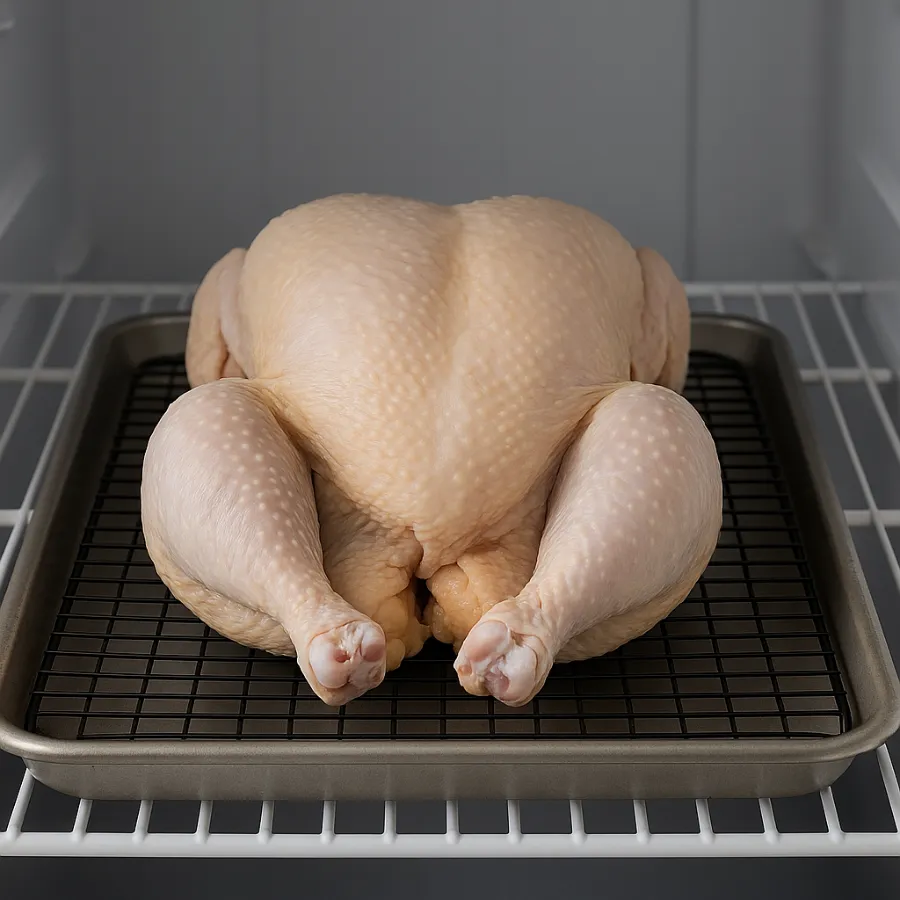
If you’re roasting, here’s my full crispy roast chicken process:
- Brine overnight with a sugar-salt mix.
- Rinse and pat dry.
- Air-dry in the fridge uncovered for at least 4 hours.
- Roast at high heat (425–450°F).
- Finish with butter or oil to deepen color and crispness.
- Rest before carving so the juices settle without softening the skin.
The result? Crispy, juicy, deeply flavorful roast chicken that’s golden all over — not just in patches.
Maillard Reaction: The Chemistry of Browning
Let’s nerd out for a second. The Maillard reaction is what makes roasted food smell and taste irresistible. When sugar molecules meet proteins at high heat, they form hundreds of new flavor compounds. This reaction is why sugar brine delivers that bronzed skin and roasted aroma that makes you hungry before you even slice into the chicken.
Without enough sugar on the surface, the Maillard reaction stays weak — so the skin browns unevenly. That’s why sugar is essential to the science of crispy chicken.
Caramelization: Where Color and Crunch Are Born
Separate from Maillard, caramelization is when sugar itself breaks down under heat to form rich color and flavor. It starts around 320°F (160°C) and continues as the temperature rises.
Caramelization gives your chicken that golden sheen and subtle sweetness that perfectly balances the savory fat underneath. When sugar is part of the brine, the process happens evenly across the skin instead of just in hot spots.
Brine vs Marinade: The Clear Winner for Crispy Skin
People often confuse the two, but when it comes to crispy skin, brine vs marinade isn’t even a competition.
| Technique | Base Ingredients | Purpose | Effect on Skin |
|---|---|---|---|
| Brine | Water, salt, sugar | Adds internal moisture and seasoning | Promotes dryness and crispiness |
| Marinade | Oil, acid (vinegar, citrus), herbs | Adds surface flavor only | Often keeps skin too wet to crisp |
Marinades are great for flavoring, but their moisture and acidity make it hard to achieve that brittle, shattering crust. Brining, especially with sugar, changes the meat’s texture from the inside and preps the skin for crisp perfection.
My Hybrid Trick: Dry Brining with Sugar
When I’m short on time, I sometimes use a dry brine with sugar. Mix 1 tablespoon of kosher salt and 1 tablespoon of sugar per pound of chicken. Rub it all over (and under) the skin, then refrigerate uncovered for 12–24 hours.
This technique pulls out surface moisture, then lets the salt and sugar reabsorb into the meat. When cooked, the chicken skin dries, crisps, and browns faster — all without a drop of water.
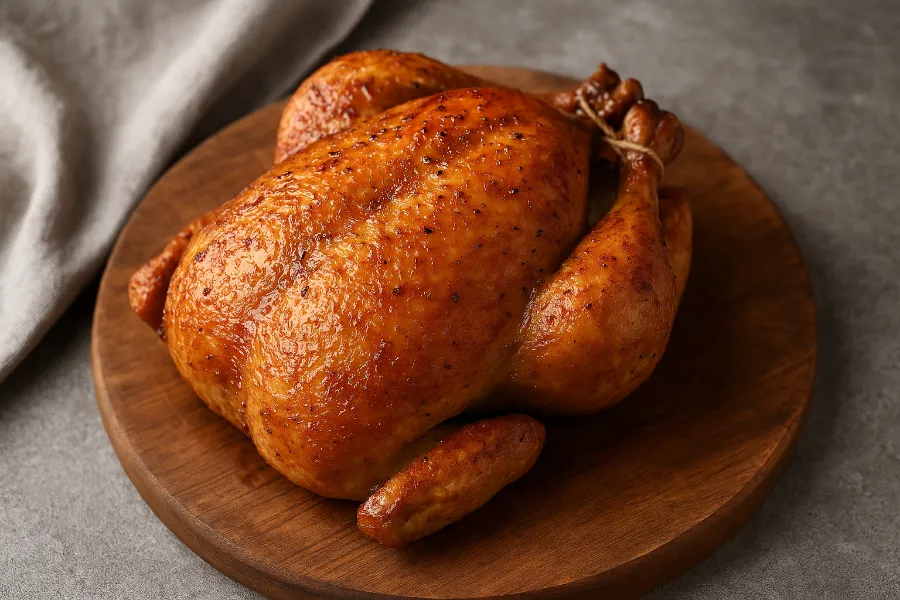
Final Thoughts: Sweetness Is the Secret to Crispness
Sugar isn’t just a background player in brining — it’s the key to that perfect bite of golden, crackling chicken skin. It fuels both Maillard reaction and caramelization, balances salt, and encourages even browning.
Whether you’re roasting, grilling, or smoking, adding sugar to your brine transforms ordinary chicken into something extraordinary.
So the next time you set out to cook chicken, skip the plain saltwater soak. Go with a sugar brine, give it time to air-dry, and get ready for skin so crispy you’ll hear it before you taste it.
FAQs
Sugar helps balance saltiness, promotes browning, and supports the Maillard reaction. It’s the key to getting golden, crispy chicken skin with deeper flavor.
Use about ½ to 1 cup of sugar per gallon of water. This ratio gives balanced sweetness and perfect caramelization without burning.
White, light brown, and turbinado sugars work best. They caramelize evenly under heat and create glossy, crisp skin without overpowering sweetness.
Yes, but use less—about ¼ cup per gallon—since liquid sugars burn faster. They add rich flavor and shine to roasted or grilled chicken.
No. When cooked, the sugar doesn’t taste sugary—it enhances savoriness and boosts browning, resulting in balanced, flavorful skin.
For a whole chicken, brine for 8–12 hours. Smaller cuts like thighs or breasts only need 1–4 hours to absorb flavor and moisture.
Brine wins every time. Marinades add flavor, but brines (especially with sugar) change the meat’s texture and dry the skin for crispiness.
Yes, but use less—about ¼ cup per gallon—since liquid sugars burn faster. They add rich flavor and shine to roasted or grilled chicken.

